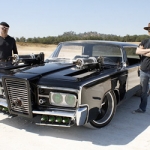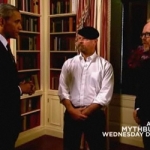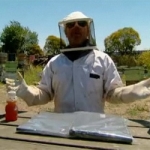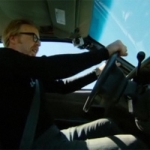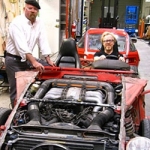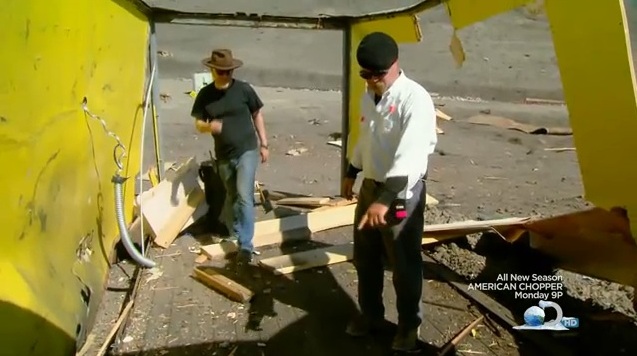
Episode: MythBusters 8.29 – “Operation Valkyrie”
Original Air Date: December 22, 2010
After too many movie myths and promotional episodes over the last few months, the MythBusters finally managed to pull themselves together and go out with a bang in their last episode of the year, both figuratively and literally. Adam and Jamie address an interesting historical “what if” — what if the location for Hitler’s briefing on July 20, 1944 hadn’t been changed from the underground bunker to an above-ground, windowed conference room? Would we still be remembering the martyrs behind the “Valkyrie” assassination plot or celebrating an earlier end to World War II? On a lighter note, Kari, Grant, and Tory dabble in a bit of slapstick comedy as they test a popular saying — can you really “slap some sense” into someone when they’re hysterical or otherwise temporarily impaired? Keep reading to find out!
Myth #1: If Hitler’s briefing on July 20, 1944 hadn’t been moved from an underground bunker to an above-ground conference room, the Valkyrie plot would have succeeded because the solid walls of the bunker would have contained the shock waves from the explosion, causing much more damage and casualties than in the conference room, where the shock waves were able to escape through the room’s windows.
MythBusters: Adam and Jamie
Procedure:
- Research actual events to find out specific details such as the damage caused, amount of explosives used, position of people and objects in the conference room, etc.
- Build two small-scale rooms from steel plate, one with window openings and one without. Fit each with a pressure transducer and a small explosive charge. Detonate the explosives and look at the data from the pressure transducers to determine if the presence or absence of windows in the model made a difference in the pressure waves created by the explosives.
- Obtain two metal shipping containers. Place one of them in a trench dug into the side of a hill and cover the top with dirt. Place the other above ground and cut windows into it. Place a historically accurate map table in each container. Near each table, in about the place where Hitler was standing when the bomb went off, place a Hitler-sized block of foam containing pressure sensors at chest height. Place burst disks in each container. Place a leather briefcase containing a historically accurate amount and type of explosive in the historically accurate position in each container. Detonate the explosives. Observe and analyze the results.
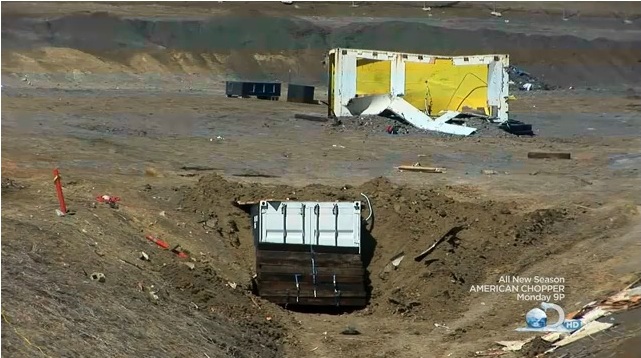
Results: In the small-scale tests, the pressure transducer in the above ground conference room model registered a peak pressure of 14 psi. The pressure transducer in the underground bunker model registered a peak pressure of 55 psi. In the large-scale tests, the above ground container showed similar damage to that seen in photographs taken after the explosion in 1944. The 100 psi burst disk was still intact, showing that the pressure in the room never reached that high. The pressure transducers in the foam block registered a peak pressure of 18 psi for just over a millisecond. In the underground container, the burst disks were also intact. The pressure transducers registered a peak pressure of 30 psi for just over a millisecond.
Conclusion: The small-scale tests showed the validity of the explanation often given for this myth — pressure waves in an enclosed space are more dangerous because they are contained instead of dissipating outwards, as shown by the higher pressure readings in the enclosed box than the box with window openings. The full-scale results, however, surprised our hosts. The amount of pressure registered by the sensors in both explosions was not high enough and did not last long enough to cause death — the peak pressure would have had to last more than 30 milliseconds to be lethal. Jamie concluded that the amount of explosives and the placement of the bomb were more important factors than the location of the explosion. Myth Busted.
Myth #2: When someone is hysterical or panicked, slapping him or her will cause the person to come to his or her senses.
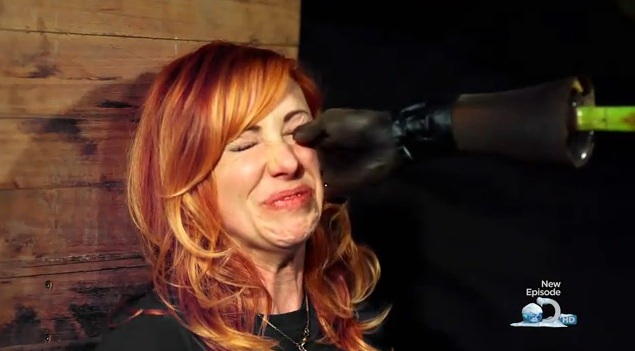
MythBusters: Kari, Grant, Tory
Procedure:
- Talk to a trauma expert about why this myth might be true and find out the best ways to bring about temporary impairment similar to a state of panic.
- Build a slapping robot that will swing a silicone hand around and hit someone in the face with the same force as a slap. Make a mold of Kari’s hand and forearm and use it to cast a silicone model. Mount the silicone hand onto the slapping device.
- Have each team member slap a force plate to register the amount of force with which they could slap someone. Average the three numbers. Calibrate the slapping robot so that it will hit with the same amount of force.
- Have each team member sit in the device and be slapped by silicone hand, for the purpose of generating high-speed camera footage for audience amusement.
- Devise four tests: Reflexes (catching objects dropped at random intervals), Coordination (6 targets to be shot with a cork gun in a time limit of 60 seconds), Communication (verbally direct a blindfolded teammate to arrange various shapes into a specific pattern), and Calculation (solve several math problems that are not difficult but written out in such a way as to be long and involved).
- Have the subject perform each of the tests. Record the results.
- Obtain a truck and place several large blocks of ice inside. Place the subject in the cold truck for thirty minutes to create physical and mental impairment comparable to that experienced by someone in a state of panic.
- Repeat step 6.
- Place the subject back in the ice-filled truck for another 30 minutes. Remove the subject from the truck and place him in the slapping mechanism. Administer a slap.
- Repeat step 6, placing the subject back in the truck for a short period of time and administering another slap between each of the four tests.
Results: Grant ended up being the subject because he looked the funniest on the high-speed camera when being slapped by the slapping robot. His scores on each of the four tests were much worse after sitting in the ice-filled truck for 30 minutes than under normal conditions, where he did quite well. The third time, after being chilled and then slapped, he performed better on each of the four tests but not as well as under unimpaired conditions.
Conclusion: This myth is looking plausible, but just to be sure, another test should be devised for Kari and Tory to take when even more impaired than Grant was. And to give Grant the opportunity for retaliation.
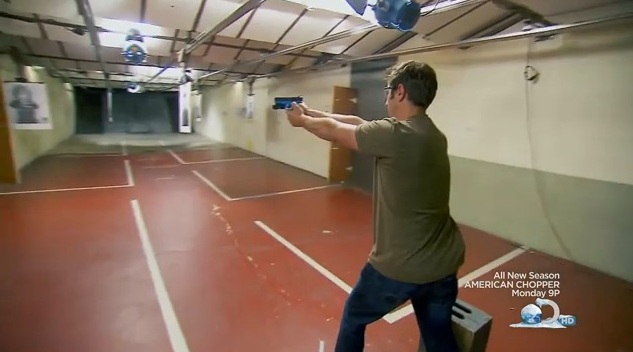
Procedure:
- Set up “good guy” and “bad guy” targets on a shooting range. Give the first subject a pistol and a clip of training rounds that contain paint to mark hits. Make targets appear and instruct subjects to shoot only the bad guys. Evaluate the accuracy of the subject’s shots. Repeat with the second subject.
- After subjects have refrained from eating or sleeping for a day, place them in the ice truck. After 30 minutes, remove them and repeat step 1.
- Place subjects back in the ice truck. After 30 minutes, remove them and then place them in the slapping mechanism. Administer one slap, then repeat step 1.
- Analyze the results.
Results: In all three tests, neither Kari nor Tory hit any good guys. Similar to Grant’s results in the first set of tests, both subjects’ percentage of hits on the bad guy targets was higher than their impaired score after being slapped, but neither had as high a percentage of hits as when they took the test unimpaired.
Conclusion: Myth Confirmed. According to the trauma expert, being slapped causes the “fight or flight” response in the body. The release of adrenaline and increased blood flow help the subject to overcome the physical and mental impairment brought on by a state of panic or hysteria, or similarly, near-hypothermic conditions.
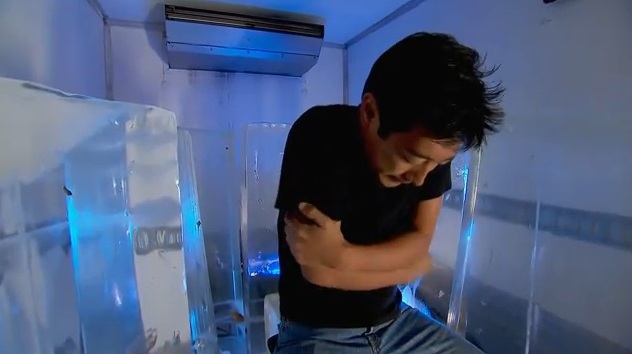
Episode Conclusions: Finally, an enjoyable episode to end the year on, especially after the sub-par performances of the previous several months. These types of myths should be the MythBusters’ bread and butter, not going up against the always-superior Hollywood special effects departments. I was actually a little bit surprised by Kari, Grant, and Tory’s results, but I enjoyed watching them in the process — especially the gratuitous slow-motion slaps.
As for Adam and Jamie’s myth, the alternate history approach can be very thought-provoking. I was very engaged in what they were doing and eager to find out the results, right up until the last test where they detonated the explosives in the “underground” cargo container. It wasn’t completely underground — the two large doors that make up one whole end of the container were barricaded only by a bunch of railroad ties that didn’t even cover the whole surface of the exposed side. As a result, the force of the blast came straight out through the doors, blowing them open and scattering the railroad ties. I can’t help but think (and from the comments I have read in various places on the Internet, I am not alone in my opinion) that if the container had truly been underground — surrounded by a lot of dirt on all sides — that the results would have been much different. In their analysis, Adam and Jamie seem not to have noticed this. I’m sure they will receive a great deal of feedback from the viewers, however, and I look forward to a revisit sometime in the future.
Rating: 4 / 5 Stars


